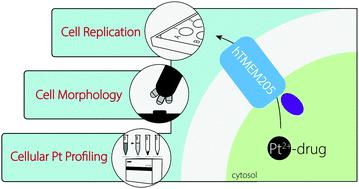当前位置:
X-MOL 学术
›
Metallomics
›
论文详情
Our official English website, www.x-mol.net, welcomes your
feedback! (Note: you will need to create a separate account there.)
A recombinant platform to characterize the role of transmembrane protein hTMEM205 in Pt(ii)-drug resistance and extrusion.
Metallomics ( IF 2.9 ) Pub Date : 2020-07-15 , DOI: 10.1039/d0mt00114g Marc J Gallenito 1 , Tahir S Qasim 1 , Jasmine N Tutol 1 , Ved Prakash 2 , Sheel C Dodani 1 , Gabriele Meloni 1
Metallomics ( IF 2.9 ) Pub Date : 2020-07-15 , DOI: 10.1039/d0mt00114g Marc J Gallenito 1 , Tahir S Qasim 1 , Jasmine N Tutol 1 , Ved Prakash 2 , Sheel C Dodani 1 , Gabriele Meloni 1
Affiliation

|
Platinum-coordination complexes are among the most effective chemotherapeutic drugs used in clinics for the treatment of cancer. Despite their efficacy, cancer cells can develop drug resistance leading to treatment failure and relapse. Cellular uptake and extrusion of Pt(II)-complexes mediated by transmembrane proteins are critical in controlling the intracellular concentration of Pt(II)-drugs and in developing pre-target resistance. TMEM205 is a human transmembrane protein (hTMEM205) overexpressed in cancer cells that are resistant to cisplatin, but its molecular function underlying – resistance remains elusive. We developed a low-cost and high-throughput recombinant expression platform coupled to in vivo functional resistance assays to study the molecular mechanism by which the orphan hTMEM205 protects against Pt(II)-complex toxicity. Based on the original observation by the Rosenberg group, which led to the discovery of cisplatin, we performed quantitative analysis of the effects of Pt(II)-coordination complexes on cellular growth and filamentation in E. coli cells expressing hTMEM205. By coupling our methods with Pt quantification and cellular profiling in control and hTMEM205-expressing cells, we demonstrate that hTMEM205 mediates Pt(II)-drug export selectively towards cisplatin and oxaliplatin but not carboplatin. By mutation analysis, we reveal that hTMEM205 recognizes and allows Pt(II)-extrusion by a putative sulfur-based translocation mechanism, thereby resulting in pre-target resistance. Thus, hTMEM205 represents a new potential target that can be exploited to reduce cellular resistance towards Pt(II)-drugs.
中文翻译:

表征跨膜蛋白 hTMEM205 在 Pt(ii)-耐药性和挤出中的作用的重组平台。
铂配位复合物是临床上用于治疗癌症的最有效的化疗药物之一。尽管具有疗效,癌细胞仍会产生耐药性,导致治疗失败和复发。细胞摄取和Pt(挤出II)-complexes通过跨膜蛋白介导的在控制的Pt的细胞内浓度(临界II)-drugs和在显影前的目标电阻。TMEM205 是一种人类跨膜蛋白 (hTMEM205),在对顺铂耐药的癌细胞中过度表达,但其潜在的分子功能——耐药性仍然难以捉摸。我们开发了一种低成本、高通量的重组表达平台,与体内功能抗性试验来研究孤儿 hTMEM205 防止 Pt( II )-复合物毒性的分子机制。基于导致发现顺铂的 Rosenberg 小组的原始观察,我们对 Pt( II )-配位复合物对表达 hTMEM205 的大肠杆菌细胞的细胞生长和成丝的影响进行了定量分析。通过将我们的方法与对照和 hTMEM205 表达细胞中的 Pt 定量和细胞分析相结合,我们证明 hTMEM205 介导 Pt( II )-药物选择性地向顺铂和奥沙利铂输出,但不向卡铂输出。通过突变分析,我们发现 hTMEM205 识别并允许 Pt( II)-通过推定的基于硫的易位机制挤出,从而导致前靶阻力。因此,hTMEM205 代表了一个新的潜在目标,可用于降低细胞对 Pt( II )-药物的耐药性。
更新日期:2020-08-14
中文翻译:

表征跨膜蛋白 hTMEM205 在 Pt(ii)-耐药性和挤出中的作用的重组平台。
铂配位复合物是临床上用于治疗癌症的最有效的化疗药物之一。尽管具有疗效,癌细胞仍会产生耐药性,导致治疗失败和复发。细胞摄取和Pt(挤出II)-complexes通过跨膜蛋白介导的在控制的Pt的细胞内浓度(临界II)-drugs和在显影前的目标电阻。TMEM205 是一种人类跨膜蛋白 (hTMEM205),在对顺铂耐药的癌细胞中过度表达,但其潜在的分子功能——耐药性仍然难以捉摸。我们开发了一种低成本、高通量的重组表达平台,与体内功能抗性试验来研究孤儿 hTMEM205 防止 Pt( II )-复合物毒性的分子机制。基于导致发现顺铂的 Rosenberg 小组的原始观察,我们对 Pt( II )-配位复合物对表达 hTMEM205 的大肠杆菌细胞的细胞生长和成丝的影响进行了定量分析。通过将我们的方法与对照和 hTMEM205 表达细胞中的 Pt 定量和细胞分析相结合,我们证明 hTMEM205 介导 Pt( II )-药物选择性地向顺铂和奥沙利铂输出,但不向卡铂输出。通过突变分析,我们发现 hTMEM205 识别并允许 Pt( II)-通过推定的基于硫的易位机制挤出,从而导致前靶阻力。因此,hTMEM205 代表了一个新的潜在目标,可用于降低细胞对 Pt( II )-药物的耐药性。









































 京公网安备 11010802027423号
京公网安备 11010802027423号